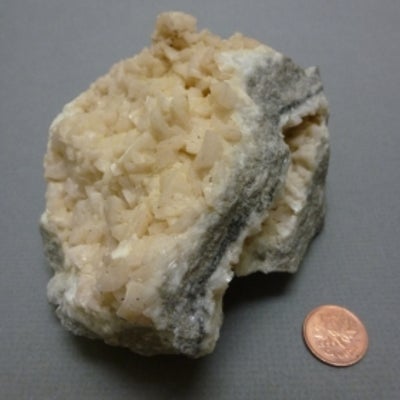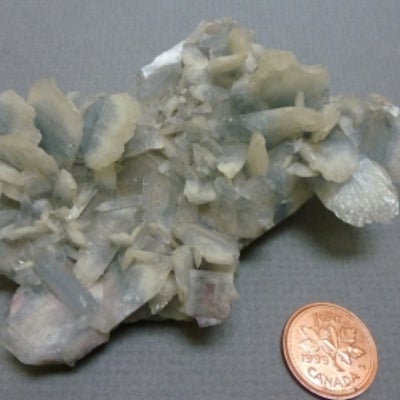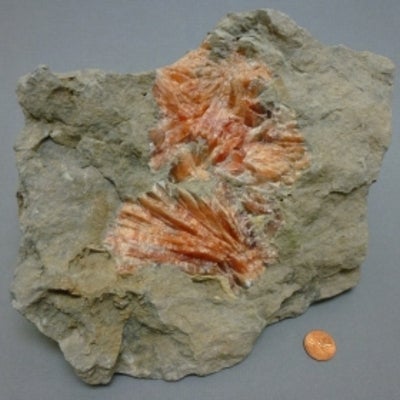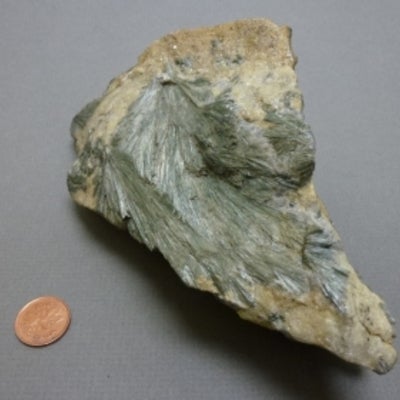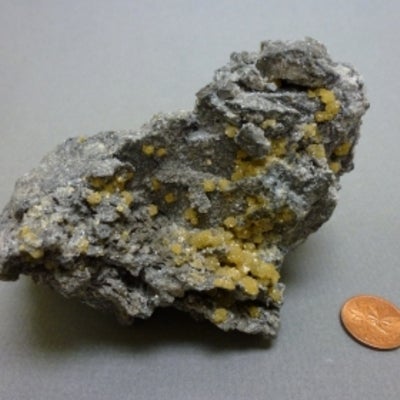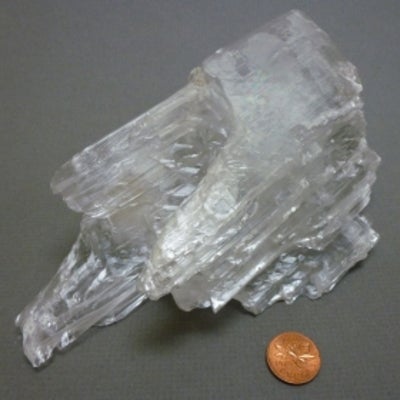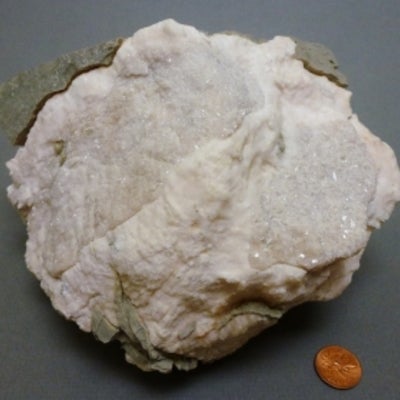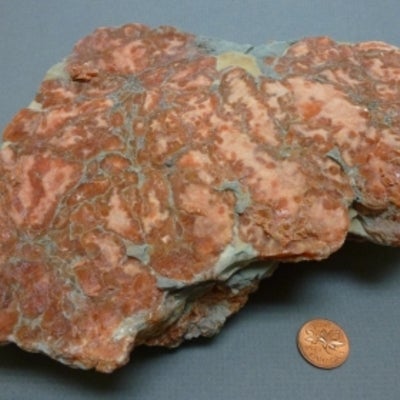View a slide show of minerals common to Southern Ontario and below that, read about the geologic history of the area.
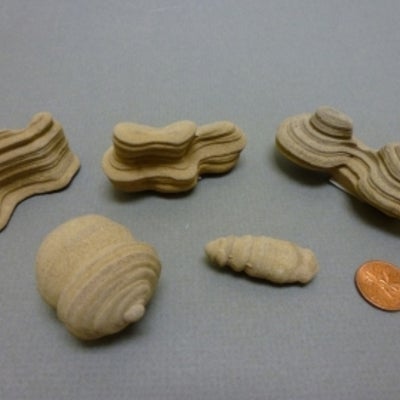
Dolostone is a common sedimentary rock which can be found in massive beds several hundred feet thick. Disputes have arisen as to how these dolomite beds form as at present time, dolomite does not form on the surface of the Earth, yet massive layers can be found in ancient rocks. Dolostone Forms Dundas, Ontario:
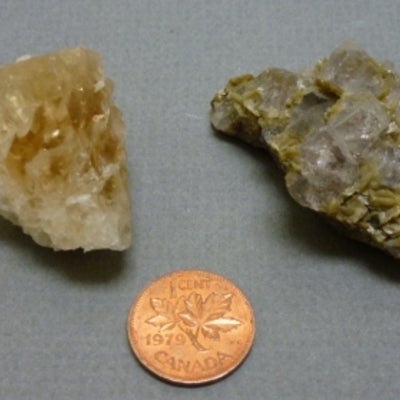
Fluorite is a halide mineral with the chemical formula CaF2. Fluorite gave its name to the phenomenon fluorescence in 1852, as this phenomenon is very commonly and easily seen in fluorites. Crystals comes in a wide range of colours, which has led to fluorite being titled “the most colourful mineral in the world”. Lafarge Quarry, Dundas, Ontario
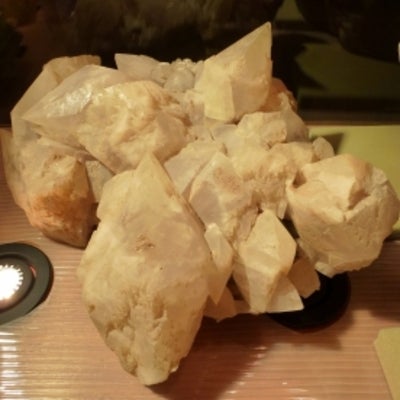
There are more than 300 crystal forms identified in calcite and these forms can combine to produce thousands of different crystal variations. Possibly the most well known of calcite’s varieties is the classic scalenohedron. The pointed end of the scalenohedron crystal is sharp, resembling the canine tooth of a dog, hence the common name “dogtooth spar”. Scalenohedral Calcite, Kingston
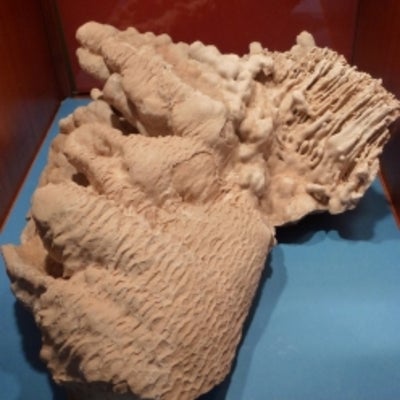
Calcite saturated-waters percolate down into the caverns below. As the enriched water enters the relatively dry caverns, the water starts to evaporate and thus precipitates calcite. Stalactites and stalagmites are two of the most well-known cave formations. Stalactites hang from the ceiling, while their corresponding formation on the floor of the cave is known as the stalagmite. This stalactite is from Paris, Ontario.
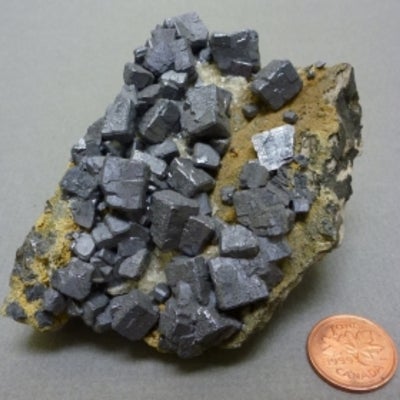
Galena is the mineral form of lead sulphide, with the chemical formula PbS. It is the most important lead ore mineral, and is commonly associated with silver. Galena deposits can be found worldwide in a variety of environments. It usually crystallizes into the cubic system, though sometimes it forms octahedrons. Lafarge Quarry, Dundas, Ontario










Southern Ontario History
Overlaying the Canadian Shield southern Ontario are young Paleozoic sedimentary rocks with ages ranging from 540 – 360 million years! Fossil evidence suggests that these sedimentary rocks were formed when this part of the world was situated near the equator. At this point in geologic history, Ontario was covered by warm shallow tropical seas that were booming with life and biodiversity.
The areas of deposition were controlled by the topography of the basement rock, which was the Canadian Shield in this scenario. These rock formations were deposited from the Cambrian to late Devonian and were composed of the sandstones and shales which commonly hosted calcareous skeletons of marine creatures.
Limestone was formed in these tropical seas. Through changes in temperature or acidity of the water in these tropical seas, different minerals precipitate out of the water to form the rocks. For limestone, calcium carbonate is precipitated out of the water as calcite and commonly incorporates the remains of aquatic animals (shells, coral etc.) to form these chemical sedimentary rocks. The combination of circulating seawater and burial caused the calcium-rich rocks to be changed from limestone (calcium-rich) to dolostone (magnesium-rich) through a process called dolomitization. Fossils are often well preserved in limestone and dolostone rocks due to high sedimentation rates and minimal sediment disruption.

Spirifer sp. is fossilized within a grey limestone matrix.
This process causes pores to form. Pores form as a result of the dissolution of feldspar, carbonate, and volcanic ash. Another way these pores are formed is through “shrinkage” of minerals, commonly recrystallization of minerals or dehydration of mud. These cavities/pores are perfect places for new minerals to precipitate out of the seawater and crystallize onto the edges of these spaces, creating vugs! Many different minerals can precipitate out of the seawater, and it all depends on what elements are present in the water. Some common minerals to precipitate include calcite, dolomite, celestine, maracaist, and fluorite.
Some of these rocks cannot be seen at the surface today because they have been covered with unconsolidated sediment called till. These sediments were deposited by the glaciers that morphed the landscape relatively recently, only approximately 20 000 years ago. As the glaciers scraped along the surface of the earth, material (rocks, sediment, rock flour, etc) accumulated at the base of the glacier and were strewn across the landscape as the ice sheet retreated.
Economically Important Minerals and Paleozoic Rocks in Southern Ontario
Deposits of lead and zinc sulphides (sphalerite and galena) may be linked to regional-scale metamorphism (related to plate tectonic movements) and hydrothermal activates.
Occasionally areas became geographically sealed off from access to open ocean, preventing regular water circulation. Over time, the saltwater completely evaporated and left behind massive deposits of salt and gypsum. Southern Ontario houses the largest underground salt mine in the world! The salt beds in the Goderich, Ontario were found through an unsuccessful search for oil. The mine is located approximately 550 m below ground surface (almost the same depth as the CN Towers height) and extends 13 km2 right underneath Lake Huron. This mine produces over 7 million tons of salt annually, and its most common use is for highway de-icing.

Definitions
Sedimentary Rocks: Consist of material derived from pre-existing rocks through physical erosion and chemical weathering.
Regional-scale metamorphism: Metamorphism produced by pressure associated with the development of folded (wrinkled) mountain ranges.
Hydrothermal: Of or pertaining to hot water, to the action of hot water, or to the products of this action, such as a mineral deposit precipitated from a hot aqueous solution, with or without demonstrable association with igneous processes; also, said of the solution itself. Hydrothermal is generally used for any hot water but has been restricted by some to the water of magmatic origin.
Deposition: The process of natural accumulation of rock material thrown down or collected in strata by water, wind, or volcanic action; also, the material is deposited.
Basement rock: A name commonly applied to metamorphic or igneous rocks underlying the sedimentary sequence.
Topography: The general configuration of a land surface or any part of the Earth's surface, including its relief and the position of its natural and man-made features.
Calcareous: Said of a substance that contains calcium carbonate. When applied to a rock name, it implies that as much as 50% of the rock is calcium carbonate.
Recrystallization: The formation, essentially in the solid state, of new crystalline mineral grains in a rock. The new grains are generally larger than the original grains and may have the same or a different mineralogical composition.
Unconsolidated sediment: A sediment that is loosely arranged or unstratified, or whose particles are not cemented together, found either at the surface or at depth.
